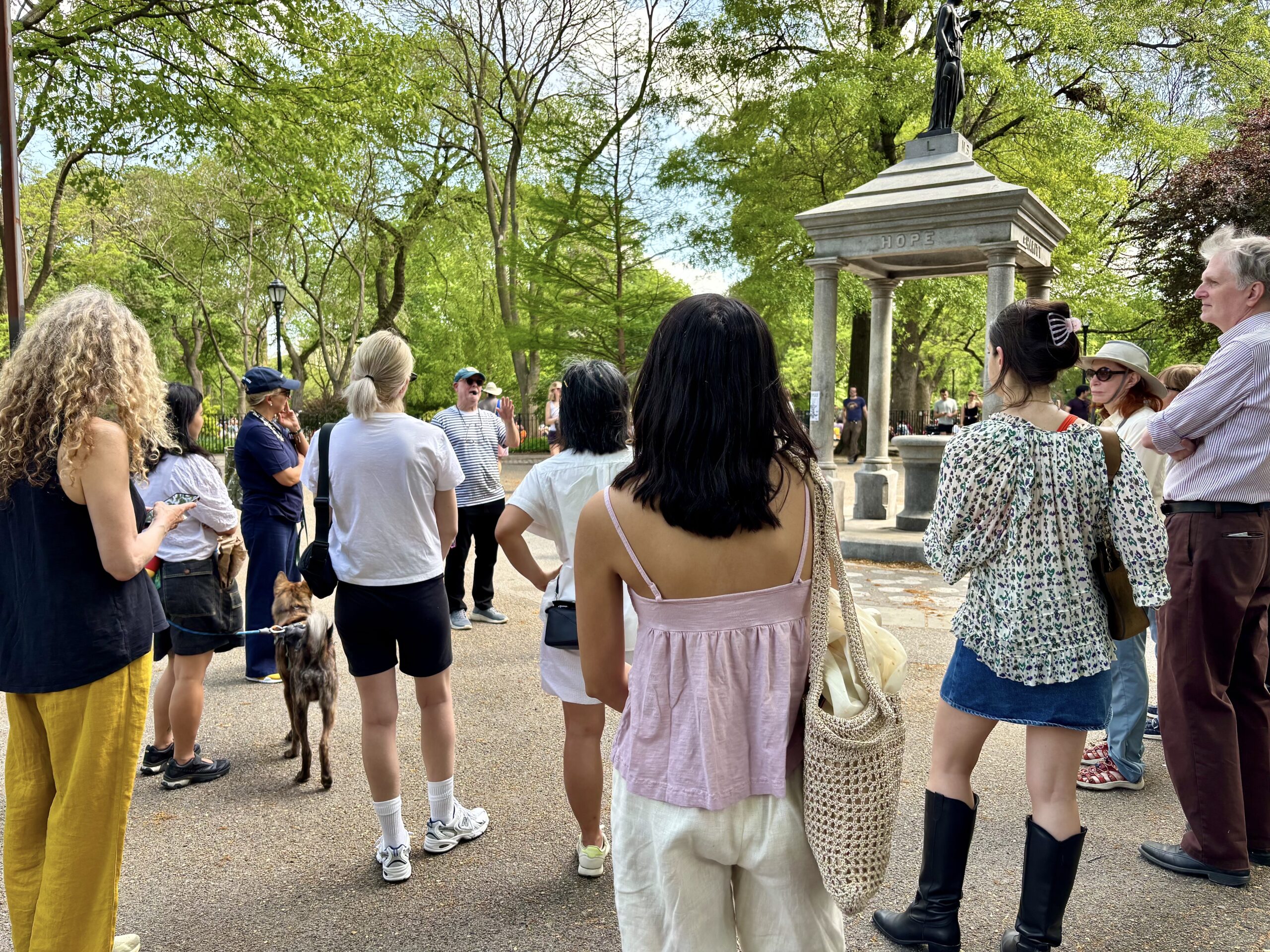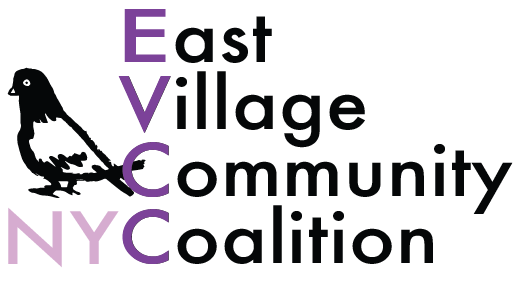Lower East Side History Month got off to a flying start in Tompkins Square Park during the first weekend of May
by Robin McMillan
On May 2, 3, and 4—a long weekend!—a group of 30 amateur historians gathered each day at 3 pm just inside the Avenue B/East 9th Street entrance to Tompkins Square Park, then for the next 90 minutes toured the compact square to learn about a life story that goes back more than 200 years. Even the threat of heavy rain—which turned out to be more of a random drizzle—could not dampen the spirits of the slightly smaller Sunday group. Tompkins has a lot of history to keep one intrigued.
The tours—led by yours truly and by East Village Community Coalition Executive Director Laura Sewell— were part of the Municipal Arts Society of New York’s “Jane’s Walk NYC 2025” weekend. The annual festival of free, community-led “walking conversations” is named for Jane Jacobs, the late urbanist activist and author best known for taking on—and beating!—New York State’s autocratic chief urban planner Robert Moses when he tried to bulldoze a highway through Greenwich Village. Jacobs, born in Scranton, Pa., but who lived the latter half of her life in Canada, also wrote the seminal book “The Death and Life of Great American Cities” in 1961.
Tompkins has been the site of Jane’s Walks before, but in previous years they focused mainly, and with good historical reason, on the riots of 1988. The 2025 walks instead covered the entire Park history: the evolution of the 10.5-acre space; the different immigrant communities; the myriad activities, both conservational and recreational, and the landmarks and people who over the decades have made Tompkins a microcosm of the city in which it resides.
These walks were the extension of a series of talks (and a walk!) hosted by the Tompkins Square Library last fall. I curated that five-day “Friends and Neighbors” festival, working closely with the EVCC. We highlighted many aspects of the park, including its flora and fauna, its history, its musical and theatrical heritage, and its community involvement. MAS’s Jane’s Walks simply allowed us to bring the Tompkins story to life for a wider audience.
On each of the three days, we followed the same route:
- Before our circumnavigation, we began with the evolution of the park, from swampy saltmarsh, to a planned, four-block-long market in 1811, to various iterations of the current footprint, before the current design took hold in the 1930s.
- As we visited the memorial to the 1,021 victims of the General Slocum disaster—a 1904 fire aboard a passenger ship of that name that was taking a German church group to Long Island—we also noted that the Slocum memorial fountain was part of a recent renovation of the Tompkins Field House area. During Saturday’s tour, we also shared the space with volunteers from the Lower East Side Ecology Center, who were handing out compost and bulbs, teaching visitors about tree care, and even giving watercolor art lessons on painting different leaves!
- At the west side of the Park, on Avenue A, we discussed three accomplished figures: Dr. Henry Cogswell, a dentist who made his fortune in California real estate before building the Temperance Fountain, one of a network of similar fountains across the country; Milan Stefanik, a Slovakian war hero (and astronomer!) who helped unite his own country with the Czech Republic after World War 1; and Samuel Cox, whose statue on the corner of Avenue A and E7th Street pays tribute to his success as a congressman in passing a law giving postal workers regular hours and benefits.
- In the open area beneath the Krishna tree—yes, we covered the source of its name—tourists learned about Wigstock, Howl, the current punk and rock concerts, the Charlie Parker Jazz Festival, the New Village Music Festival, the Theatre for the New City, and of course that legendary afternoon in 1967 when the Grateful Dead made Tompkins the site of its very first gig in New York City.
- Throughout our tour we pointed out other significant people and dates: the city’s first dog run and Halloween dog parade, both from 1990; the pollinator gardens in the southeastern corner, the work of the volunteer Friends of Tompkins Square Park; the E9th Street “corridor” created by Moses to separate physical recreation—now mainly skateboarding and basketball—from the rest of the park; the Sandra Turner Garden, by the Field House, named for the founder of the East Village Parks Conservancy; and the approximate area where the park’s resident family of red-tailed hawks nest and hang out.
- After stopping to hear the story of the Holiday Tree, which doubles as an AIDS memorial, the tour finished—by now on Sunday the rain was really coming down—with the story of Daniel D. Tompkins himself. The man who lends the Park its name is buried a few blocks away, in St. Mark’s Church-in-the-Bowery on Second Avenue, and has a region of Staten Island he settled and incorporated in 1915 named for him—“Tompkinsville”—but beyond that he remains all but anonymous. But the truth is that he was Governor of New York State four times, Vice-President of the United States twice, a NY State Supreme Court judge, valedictorian at Columbia University, the founder of the Staten Island Ferry—and during the War of 1812 he was the military and political savior of New York City, New York state, the northeastern U.S., and perhaps the entire Republic. Perhaps Tompkins’ most significant success, however, was that it was his ardent advocacy as Governor that led directly to the 1817 Act that abolished slavery in New York State. And he did all this before his untimely death at the age of 50.
The 200th anniversary of the abolishment of slavery in New York State is almost upon us—it called for complete abolishment by July 4, 1827—and in the months leading up to that, the EVCC hopes to raise awareness of Tompkins’ life through a series of articles, webinars, and more, working again with the Tompkins Square Library. Plans are in early stages of development now—so watch this space!


